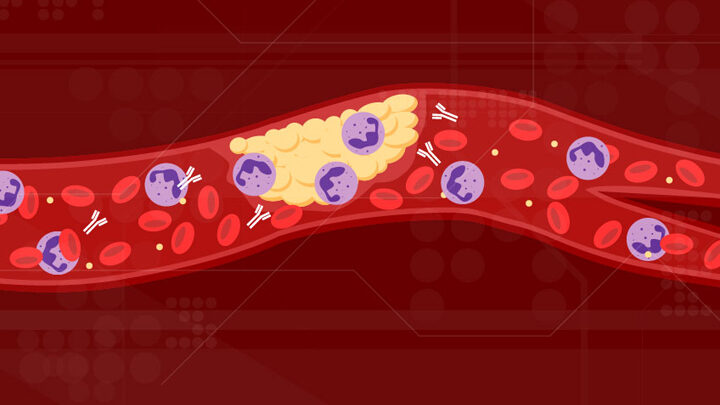The observational study, published Thursday in the British Medical Journal, reports an increased risk of deep vein thrombosis, a blood clot in the leg, up to three months after COVID-19 infection; pulmonary embolism, a blood clot in the lung, up to six months later and a "bleeding event" up to two months.
According to researchers from Umea University, these events were higher in patients with underlying health conditions and those with more severe COVID-19.
Researchers also found there were more blood clot-related events reported during the first pandemic wave, compared with the second and third waves. However, they note this could be due to improvements in treatment and vaccine coverage in older patients following the pandemic's first wave.
The study's authors say the findings suggest that COVID-19 is an "independent risk factor" for blood clots and bleeding.
Researchers say the results highlight the importance of using medical treatments such as blood thinners to prevent the development of thrombosis amid the pandemic. Such treatment is known as thromboprophylaxis.
"Our findings arguably support thromboprophylaxis to avoid thrombotic events, especially for high risk patients, and strengthen the importance of vaccination against COVID-19," the study's authors wrote.
Comment: Why would it strengthen the importance of vaccination against COVID when:
- The vaccine doesn't stop you from catching COVID
- The vaccine doesn't provide long-lasting immunity
- In all likelihood the vaccine increases the risk of catching COVID due to its disastrous effects on the immune system
- The long list of vaccine adverse events includes 'thrombotic events' aka blood clotting.
While a separate study published in August found that blood clots can also occur after COVID-19 vaccination, experts say the risk is much smaller compared to blood clot risk from infection.
Comment: Oh really?
Previous data has shown that COVID-19 increases the risk of serious blood clots, known as venous thromboembolism or VTE, but there has been little evidence according to researchers on the length of time this risk is increased.
To analyze the risk of deep vein thrombosis, pulmonary embolism and bleeding, such as gastrointestinal bleeding or a burst blood vessel in the brain, after COVID-19 infection, researchers looked at more than one million people with confirmed infection between February 2020 and May 2021 using national registries in Sweden.
According to the study, this was then compared to the data for more than four million people without COVID-19.
Researchers analyzed the risk of blood clots during the period after a person developed COVID-19 symptoms, compared to before they tested positive and long after signs of the virus had disappeared.
The study found a fivefold increase in the risk of developing deep vein thrombosis, a 33-fold increase in the risk of a pulmonary embolism, and a nearly twofold increase in risk for a bleeding event in the 30 days following infection.
Although the risks were highest in patients with more severe illness, those with mild COVID-19 not requiring hospitalization had a threefold increased risk of deep vein thrombosis and a sevenfold increased risk of pulmonary embolism. There was no reported increased risk of bleeding in those who experienced mild infections.
As this was an observational study, researchers say they cannot establish COVID-19 as the cause of these blood clots, but have a couple theories on why it happens. These possibilities include the virus having a direct effect on the layer of cells which line blood vessels, an inflammatory response to the virus, or the body making blood clots at inappropriate times.
Comment: See the Spartacus letter (published September 2021) for more information on the pathophysiology of COVID:
COVID-19 is not a viral pneumonia. It is a viral vascular endotheliitis and attacks the lining of blood vessels, particularly the small pulmonary alveolar capillaries, leading to endothelial cell activation and sloughing, coagulopathy, sepsis, pulmonary edema, and ARDS-like symptoms.
This is a disease of the blood and blood vessels. The circulatory system. Any pneumonia that it causes is secondary to that.1-5 In severe cases, this leads to sepsis,6,7 blood clots,8-10 and multiple organ failure,11-13 including hypoxic and inflammatory damage to various vital organs, such as the brain,14-17 heart (COVID-19 was initially thought to cause myocarditis, but this has proven rare),18,19 liver,20-22 pancreas,23-26 kidneys,27-29 and intestines.30-32
Some of the most common laboratory findings in COVID-19 are elevated D-dimer, elevated prothrombin time, elevated C-reactive protein, neutrophilia, lymphopenia, hypocalcemia, hyperferritinemia, and inflammatory cytokines, essentially matching a profile of coagulopathy and immune system hyperactivation/immune cell exhaustion.33-39
Researchers also acknowledged "several limitations" which might have affected their findings, including limited COVID-19 testing during the first wave and blood clots being underdiagnosed in patients.
Despite such limitations, researchers say their findings are "largely consistent" with similar studies on the association between COVID-19 and thromboembolic events.
In an accompanied editorial on the study, also published Thursday in the British Medical Journal, researchers at the University of Glasgow note that governments are removing public health measures and shifting to a "live with COVID" approach to managing the pandemic, despite the continued emergence of new, more transmissible variants of concern.
However, they say the new study is an important reminder of "the need to remain vigilant to the complications associated with even mild SARS-CoV-2 infection, including thromboembolism."




Cos it was the jabs.
Initially they tried pinning it on c19 you mean. But again, it’s the jab.
I wonder how accurate the Deagel report will be?